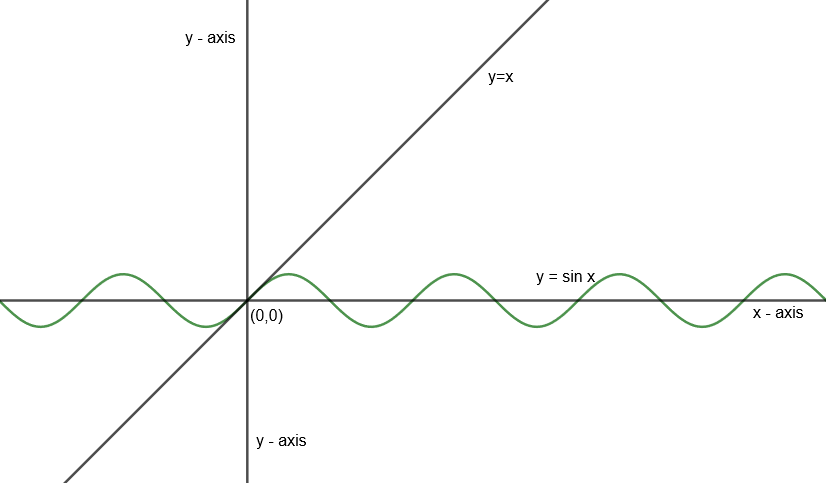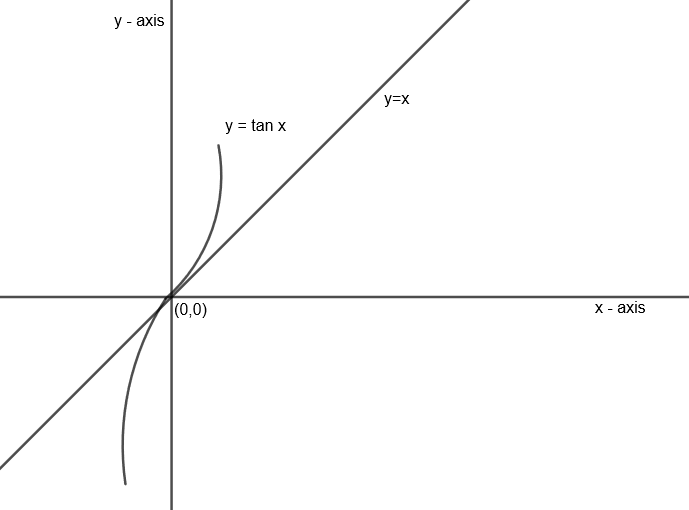
Let
(a) l exists but m does not
(b) m exists but l does not
(c) l and m both exist
(d) neither l nor m exists
Answer
529.5k+ views
Hint: Relate the relation between x, sin x and tan x when x is limiting to zero. Relate it with the domain of
Here, we have given the limits as
And,
First, we need to know about the domain of
Now, try to relate values of
Let us first relate
One can relate x with sin x and tan x by calculating tangent equations of tan x and sin x at (0, 0) and relate it with y = x.
We know that one can find tangent at any point lying on the curve by calculating slope at that point. Let the point be
Tangent equation for sin x at (0, 0) is
Hence,
Draw graph of x and sin x in one coordinate plane as follows:

Now for the second case i.e.
Hence, y = x is tangent for
Let us draw the graph of x and tan x as follows:
 Now from the graphs, we can relate for
Now from the graphs, we can relate for
Case 1:
We observe x > sin x
Hence,
Case 2:
Here, sin x has a higher positive magnitude than x. Hence, if we put a negative sign to both x and sin x, then
Hence, from case 1 and case 2, we get
If
Similarly, let us relate x and tan x for
Case 1:
x < tan x
Case 2:
x < tan x
Hence, for
Now, for limit ‘l’ from equation (i), we get
As we have
So,
For limit ‘m’ from equation (ii), we get
We have already calculated that
Hence, option (a) is the correct answer to the given problem.
Note: One can directly put
Here, we have given the limits as
And,
First, we need to know about the domain of
Now, try to relate values of
Let us first relate
One can relate x with sin x and tan x by calculating tangent equations of tan x and sin x at (0, 0) and relate it with y = x.
We know that one can find tangent at any point lying on the curve by calculating slope at that point. Let the point be
Tangent equation for sin x at (0, 0) is
Hence,
Draw graph of x and sin x in one coordinate plane as follows:

Now for the second case i.e.
Hence, y = x is tangent for
Let us draw the graph of x and tan x as follows:

Case 1:
We observe x > sin x
Hence,
Case 2:
Here, sin x has a higher positive magnitude than x. Hence, if we put a negative sign to both x and sin x, then
Hence, from case 1 and case 2, we get
If
Similarly, let us relate x and tan x for
Case 1:
x < tan x
Case 2:
x < tan x
Hence, for
Now, for limit ‘l’ from equation (i), we get
As we have
So,
For limit ‘m’ from equation (ii), we get
We have already calculated that
Hence, option (a) is the correct answer to the given problem.
Note: One can directly put
Recently Updated Pages
Master Class 9 General Knowledge: Engaging Questions & Answers for Success

Master Class 9 English: Engaging Questions & Answers for Success

Master Class 9 Science: Engaging Questions & Answers for Success

Master Class 9 Social Science: Engaging Questions & Answers for Success

Master Class 9 Maths: Engaging Questions & Answers for Success

Class 9 Question and Answer - Your Ultimate Solutions Guide

Trending doubts
State and prove Bernoullis theorem class 11 physics CBSE

Who built the Grand Trunk Road AChandragupta Maurya class 11 social science CBSE

1 ton equals to A 100 kg B 1000 kg C 10 kg D 10000 class 11 physics CBSE

State the laws of reflection of light

One Metric ton is equal to kg A 10000 B 1000 C 100 class 11 physics CBSE

Difference Between Prokaryotic Cells and Eukaryotic Cells




